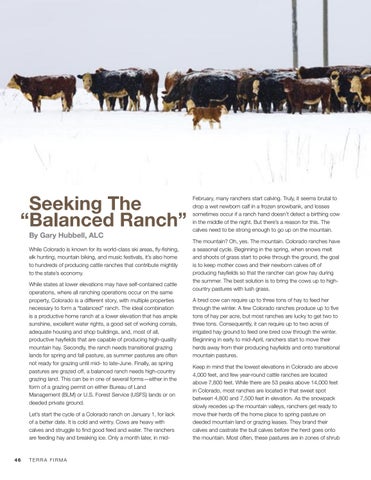Seeking The “Balanced Ranch” By Gary Hubbell, ALC While Colorado is known for its world-class ski areas, fly-fishing, elk hunting, mountain biking, and music festivals, it’s also home to hundreds of producing cattle ranches that contribute mightily to the state’s economy. While states at lower elevations may have self-contained cattle operations, where all ranching operations occur on the same property, Colorado is a different story, with multiple properties necessary to form a “balanced” ranch. The ideal combination is a productive home ranch at a lower elevation that has ample sunshine, excellent water rights, a good set of working corrals, adequate housing and shop buildings, and, most of all, productive hayfields that are capable of producing high-quality mountain hay. Secondly, the ranch needs transitional grazing lands for spring and fall pasture, as summer pastures are often not ready for grazing until mid- to late-June. Finally, as spring pastures are grazed off, a balanced ranch needs high-country grazing land. This can be in one of several forms—either in the form of a grazing permit on either Bureau of Land Management (BLM) or U.S. Forest Service (USFS) lands or on deeded private ground. Let’s start the cycle of a Colorado ranch on January 1, for lack of a better date. It is cold and wintry. Cows are heavy with calves and struggle to find good feed and water. The ranchers are feeding hay and breaking ice. Only a month later, in mid-
46
TERRA FIRMA
February, many ranchers start calving. Truly, it seems brutal to drop a wet newborn calf in a frozen snowbank, and losses sometimes occur if a ranch hand doesn’t detect a birthing cow in the middle of the night. But there’s a reason for this. The calves need to be strong enough to go up on the mountain. The mountain? Oh, yes. The mountain. Colorado ranches have a seasonal cycle. Beginning in the spring, when snows melt and shoots of grass start to poke through the ground, the goal is to keep mother cows and their newborn calves off of producing hayfields so that the rancher can grow hay during the summer. The best solution is to bring the cows up to highcountry pastures with lush grass. A bred cow can require up to three tons of hay to feed her through the winter. A few Colorado ranches produce up to five tons of hay per acre, but most ranches are lucky to get two to three tons. Consequently, it can require up to two acres of irrigated hay ground to feed one bred cow through the winter. Beginning in early to mid-April, ranchers start to move their herds away from their producing hayfields and onto transitional mountain pastures. Keep in mind that the lowest elevations in Colorado are above 4,000 feet, and few year-round cattle ranches are located above 7,800 feet. While there are 53 peaks above 14,000 feet in Colorado, most ranches are located in that sweet spot between 4,800 and 7,500 feet in elevation. As the snowpack slowly recedes up the mountain valleys, ranchers get ready to move their herds off the home place to spring pasture on deeded mountain land or grazing leases. They brand their calves and castrate the bull calves before the herd goes onto the mountain. Most often, these pastures are in zones of shrub
